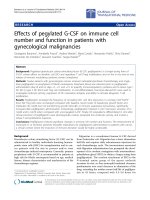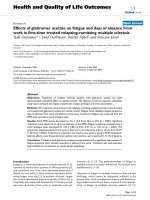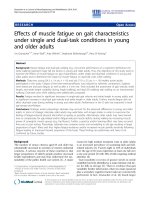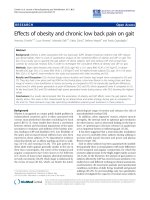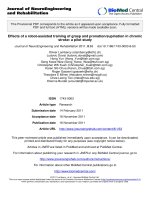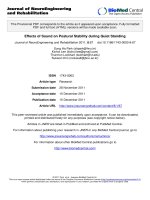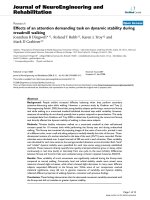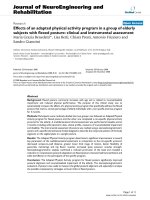báo cáo hóa học: " Effects of glatiramer acetate on fatigue and days of absence from work in first-time treated relapsing-remitting multiple sclerosis" doc
Bạn đang xem bản rút gọn của tài liệu. Xem và tải ngay bản đầy đủ của tài liệu tại đây (251.96 KB, 6 trang )
BioMed Central
Page 1 of 6
(page number not for citation purposes)
Health and Quality of Life Outcomes
Open Access
Research
Effects of glatiramer acetate on fatigue and days of absence from
work in first-time treated relapsing-remitting multiple sclerosis
Tjalf Ziemssen*
1
, Josef Hoffman
2
, Rainer Apfel
2
and Simone Kern
1
Address:
1
MS Center, Neurological University Clinic, Technical University of Dresden, Dresden, Germany and
2
TEVA Germany, Mörfelden,
Germany
Email: Tjalf Ziemssen* - ; Josef Hoffman - ;
Rainer Apfel - ; Simone Kern -
* Corresponding author
Abstract
Objectives: Treatment of multiple sclerosis patients with glatiramer acetate has been
demonstrated a beneficial effect on disease activity. The objective of this prospective naturalistic
study was to evaluate the impact of glatiramer acetate on fatigue and work absenteeism.
Methods: 291 treatment-naïve patients with relapsing remitting multiple sclerosis were included
and treated with glatiramer acetate for twelve months. Relapse rates, disability, fatigue symptoms,
days of absence from work and adverse events were monitored. Fatigue was measured with the
MFIS scale and with a visual analogue scale.
Results: Total MFIS scores decreased by 7.6 ± 16.4 from 34.6 to 27.0 (p ≤ 0.001). Significant
reductions were observed on all three subscales of the MFIS. Fatigue symptoms, assessed using a
visual analogue scale, decreased by 1.04 ± 2.88 cm from 4.47 cm to 3.43 cm (p ≤ 0.001). The
proportion of patients absent from work at least once was reduced by a factor of two from 65.1%
to 30.1% (p ≤ 0.001). Tolerance to treatment was rated as very good or good in 78.3% of patients.
Adverse effects, most frequently local injection site reactions, were reported in 15.1% of patients.
Conclusion: Treatment with glatiramer acetate was associated with a significant improvement in
fatigue symptoms and a marked reduction in absence from work. Treatment was well-tolerated.
Such benefits are of relevance to overall patient well-being.
Introduction
Fatigue is a common symptom of multiple sclerosis [1-5],
reported by around three-quarters of affected patients [3],
and considered one of the most distressing symptoms of
disease by over half [2]. Many patients experience debili-
tating fatigue every day [2]. In multiple sclerosis, fatigue
has a major detrimental impact on quality of life [6-8], is
frequently associated with depression [9,10] and is a lead-
ing cause of absence from work or impaired work per-
formance [6,11,12]. The pathophysiology of fatigue in
multiple sclerosis is poorly understood, but is likely to be
multifactorial [13-16]
Treatment of fatigue in multiple sclerosis is thus a major
challenge, which cannot be adequately achieved at the
present time. Both non-pharmacological and pharmaco-
logical interventions have been proposed for the manage-
ment of fatigue in multiple sclerosis patients [15,17],
Published: 5 September 2008
Health and Quality of Life Outcomes 2008, 6:67 doi:10.1186/1477-7525-6-67
Received: 16 May 2008
Accepted: 5 September 2008
This article is available from: />© 2008 Ziemssen et al; licensee BioMed Central Ltd.
This is an Open Access article distributed under the terms of the Creative Commons Attribution License ( />),
which permits unrestricted use, distribution, and reproduction in any medium, provided the original work is properly cited.
Health and Quality of Life Outcomes 2008, 6:67 />Page 2 of 6
(page number not for citation purposes)
although the benefits of drugs such as modafenil and
amantadine have not been demonstrated unequivocally
[18-20].
Immunomodulatory treatments for relapsing-remitting
multiple sclerosis, namely glatiramer acetate and the β-
interferons, provide a marked reduction in relapse rates
and in MRI markers of disease activity [21]. It is therefore
of interest to explore whether such treatments might influ-
ence fatigue symptoms as well. A retrospective chart
review of 218 Canadian patients receiving an immu-
nomodulatory treatment during the late 1990s revealed
that fatigue improved over the six months following treat-
ment initiation [22]. Of particular interest was the obser-
vation that a significantly higher proportion of glatiramer
acetate treated patients than β-interferon-treated patients
improved by at least one standard deviation of the Fatigue
Impact Scale (FIS).
In order to investigate further the potential impact of
immunomodulatory treatment on fatigue in multiple
sclerosis, we initiated a prospective, observational, non-
interventional study to monitor fatigue in treatment-naive
RRMS patients initiating therapy with glatiramer acetate
under conditions of daily practice. The primary objective
of study was to determine the impact of initiating treat-
ment with glatiramer acetate on fatigue and absenteeism.
Secondary objectives were to evaluate the effect of treat-
ment on clinical and MRI outcomes and to determine the
tolerability of treatment.
Methods
This study was a prospective, observational, non-interven-
tional study of patients with relapsing remitting multiple
sclerosis treated with glatiramer acetate conducted in Ger-
many. 130 ambulatory and hospital neurologists partici-
pated in the study. The study was performed between
November 2002 and October 2004.
Patients
The study included patients with a diagnosis of relapsing-
remitting multiple sclerosis by the McDonald criteria [23]
who had not previously been treated with an immu-
nomodulatory treatment and in whom the investigator
had decided to initiate therapy with glatiramer acetate.
Patients were followed for twelve months following treat-
ment initiation.
Clinical assessment
Patients were evaluated at inclusion and after 3, 6, 9 and
12 months of treatment. At each visit, patients underwent
a full neurological assessment, any relapses occurring
since the previous visit were ascertained and disability
assessed with the Expanded Disability Status Scale (EDSS)
[24]. Fatigue was assessed by the patient using a visual
analogue scale scored from 0 (no fatigue) to 10 (maxi-
mum possible fatigue) and with the Modified Fatigue
Impact Scale (MFIS) [25] in its validated German transla-
tion. This is a 21-item questionnaire which yields a total
score ranging from 0 (no impact of fatigue) to 84 points
(maximum impact of fatigue), as well as three subscales
representing the physical (score range 0 to 36), cognitive
(score range 0 to 40) and psychosocial (score range 0 to 8)
dimensions of fatigue.
Patients were questioned about any time spent off work
due to their multiple sclerosis. Due to the study protocol,
the reasons for work absentism (relapse, fatigue) could
not be differentiated. Any adverse events occurring since
the previous visit were recorded.
Statistical analysis
Number of work days lost and fatigue scores over the
course of the study were evaluated with the Wilcoxon rank
test. All comparisons were two-tailed and a p value of <
0.05 was taken as being statistically significant.
Ethics
This study was conducted according to the Declaration of
Helsinki (Hong Kong Amendment) and pertinent
national legal and regulatory requirements. Each patient
provided written, informed consent and was free to with-
draw from the study at any time for any reason without
consequences on the care provided.
Results
Study sample
A total of 338 patients were included in the study. Of
these, 53 were excluded from the analysis due to a proto-
col violation (24 patients treated previously with an
immunomodulatory therapy and 29 patients for whom
certain data were recorded retrospectively) and 47 failed
to provide complete questionnaire data. The study popu-
lation thus consisted of 291 subjects (86.1% of included
patients).
The baseline demographic and disease variables of the
study subjects are presented in Table 1. At inclusion, their
median age was 36.9 years and 74.9% were female. The
median time since diagnosis was 4.31 years. In the year
preceding inclusion, patients had experienced a mean of
1.71 relapses (retrospectively assessed) and their mean
EDSS score at inclusion was 2.58. Forty patients (13.7%)
discontinued treatment during the course of the study,
principally due to the occurrence of an adverse event (six-
teen patients).
Clinical outcome
Clinical outcome at the end of the study are presented in
Table 2. Information on relapses was missing for 24
Health and Quality of Life Outcomes 2008, 6:67 />Page 3 of 6
(page number not for citation purposes)
patients. Of the remaining 267 patients, 61 (22.8%) expe-
rienced a single relapse during the twelve-month study
period and 23 patients (8.6%) more than one relapse. The
mean annual relapse rate during the year of treatment
with glatiramer acetate was 0.46. The mean EDSS score at
the end of the study was 2.45, representing a mean
decrease from baseline of 0.55 points. The change in EDSS
score between baseline and twelve months was statisti-
cally significant (p < 0.05; Wilcoxon rank test). A sus-
tained reduction in EDSS score of > 1 point was observed
in fifteen patients (5.2%) and a sustained increase of > 1
point in three patients (1%).
Fatigue
Overall, 220 patients provided exploitable data from the
MFIS questionnaire at both inclusion and study end.
Measures were compared between the three-month
period before inclusion and the last three months of the
treatment period. Significant decreases were observed in
the total score as well as in all three dimension scores of
the MFIS (Table 3). Similarly, the VAS rating of fatigue was
reduced by around one quarter following initiation of
treatment with glatiramer acetate (Table 3), between base-
line and study end
Work absenteeism
The number of days missed from work due to multiple
sclerosis was evaluated in the patients who were in
employment (72.9% of the study population). In the
three month period preceding inclusion, 138 patients
(65.1%) had taken at least one day off work (Tables 4 and
5). This number decreased to 64 patients (30.1%) in the
year following initiation of treatment with glatiramer ace-
tate. The number of days lost was significantly lower in
the second year (p ≤ 0.001; Wilcoxon rank test).
Safety
Safety was assessed in all 338 included patients. Overall,
51 patients (15.1%) experienced at least one adverse event
during the treatment period. These were most frequently
injection site reactions or symptoms of a systemic imme-
diate post-injection reaction such as dyspnoea or tachy-
cardia. No single event was reported in more than ten
patients. The immediate post-injection reaction was clas-
sified as serious in one patient.
Discussion
In this study, immunomodulatory treatment of relapsing-
remitting multiple sclerosis with glatiramer acetate was
associated with a reduction in subjective perceptions of
fatigue and with the numbers of days taken off work due
to illness. We observed a reduction of approximately one-
quarter in both MFIS scores and in a VAS measure of
fatigue. These findings are consistent with an earlier retro-
spective study, which also reported an improvement in
fatigue measured with the FIS following initiation of glat-
iramer acetate treatment in 24.8% of patients [22]. The
two studies cannot, however, be directly compared due
differences in methodology.
The amelioration observed following treatment with glat-
iramer acetate may be a non-specific consequence of
improved overall disease status in treated patients or alter-
natively result from a specific action of the medication on
the pathophysiology of multiple sclerosis fatigue. For
Table 1: Demographic and clinical characteristics of patients at
inclusion
Population (N = 291)
Age (mean ± SD; years) 36.9 ± 9.3
Gender
Women 218 (74.9%)
Men 67 (23.0%)
Missing data 6 (2.1%)
Time since diagnosis (mean ± SD; years) 4.31 ± 5.47
ARR since diagnosis (mean ± SD) 3.82 ± 3.54
No relapses 14 (4.8%)
Up to 2 relapses 111 (38.1%)
3–5 relapses 100 (34.4%)
More than 5 relapses 57 (19.6%)
ARR within previous 12 months (mean ± SD) 1.71 ± 0.88
EDSS at treatment initiation (mean ± SD) 2.58 ± 1.44
EDSS 0–2 127 (43.6%)
EDSS 3–5 121 (41.6%)
EDSS 6–7 16 (5.5%)
Missing data 27 (9.3%)
ARR: annualised relapse rate: EDSS: Expanded Disability Status Scale;
SD: standard deviation.
Table 2: Clinical outcome
Population (N = 291)
Relapses during study (n = 267)
No relapse 180 (67.4%)
1 relapse 61 (22.8%)
2 relapses 12 (4.5%)
3 relapses 8 (3.0%)
4–5 relapses 3 (1.1%)
Mean EDSS scores (n = 235)
Baseline 2.58 ± 1.45
Study end 2.45 ± 1.52
Change from baseline -0.13 ± 0.73*
Data are presented as number of patients (%) for relapses and as
mean ± SD for Expanded Disability Status Scale (EDSS) scores. The
asterisk indicates a significant change from baseline (p < 0.05;
Wilcoxon signed rank test).
Health and Quality of Life Outcomes 2008, 6:67 />Page 4 of 6
(page number not for citation purposes)
example, it has been suggested that fatigue may be aggra-
vated by the production of high levels of pro-inflamma-
tory cytokines [26,27]. The ability of glatiramer acetate to
attenuate the secretion and activity of these cytokines
within the central nervous system [28,29] may provide
such a specific mechanism. Others have proposed, on the
basis of magnetic resonance spectroscopy (MRS) findings,
that fatigue may be associated with axonal injury in the
cortex rather than inflammatory white matter lesions per
se [30]. In a recent trial, Tedeschi et al. could demonstrate
that among MS patients with low disability those with
high-fatigue show higher white and gray matter atrophy
and higher lesion load. They suggest that in MS, inde-
pendent of disability, white and gray matter atrophy is a
risk factor to have fatigue [31]. In additon, a recent trial of
Rocca et al. using functional imaging in MS patients with
fatigue and interferon beta-1a treatment pointed out that
an abnormal recruitment of the fronto-thalamic circuitry
is associated with interferon-induced fatigue in MS
patients [32]. In contrast to the interferon's, the specific
action of glatiramer acetate to improve MRS markers of
axonal injury in multiple sclerosis might contribute to a
reduction in fatigue [33,34].
We also observed a dramatic reduction of over fifty per-
cent in the number of patients who needed to take time
off work due to their multiple sclerosis. This is consistent
with findings from an American study, which also
reported a marked decrease in days off work in patients
treated with glatiramer acetate [35], but less so with beta-
interferons. This is an important functional effect of treat-
ment since the ability to hold down a job satisfactorily is
critical for self-esteem and because, in certain countries
such as the USA, remaining in full-time employment is an
important determinant of obtaining insurance for reim-
bursement of treatment costs.
Again, the impact of glatiramer acetate on time off work
may be an indirect consequence of reduced relapse fre-
quency, although the data from the US study showing a
differential effect on time off work between glatiramer
acetate and β-interferons would argue against this. Alter-
natively, the observed effect may be secondary to a reduc-
tion in fatigue, which has been identified in other studies
to be a major reason why patients with multiple sclerosis
need to take time off work [11,12]. Finally, it should be
noted that the low incidence of debilitating side-effects
reported with glatiramer acetate [36] means that patients
are unlikely to need to take time off work due to treatment
side-effects.
The strength of this study include the naturalistic design,
which means that the findings can probably be general-
ised to standard care, at least in Europe, with confidence,
the prospective nature of the data collection and the rela-
tively large numbers of patients evaluated. Limitations
include the absence of a comparator group against which
the magnitude of the observed treatment effects could be
assessed, and data collection during physician consulta-
tions rather than with patients' diaries, which may have
introduced some degree of anamnestic error into the find-
ings. The absence of a control group might overestimate
the improvement in fatigue symptoms. As a placebo
group is probably not ethical it will be further of interest
to compare prospectively the benefit on fatigue in a group
of naive MS patients treated with GA vs. a group treated
with IFN-beta in a next study.
Table 3: Fatigue ratings.
Baseline On treatment Mean Change p
MFIS Total score (n = 220) 34.6 ± 18.7 27.0 ± 18.6 -7.6 ± 16.4 p ≤ 0.001
Physical dimension score 17.6 ± 9.1 13.5 ± 9.0 -4.1 ± 8.1 p ≤ 0.001
Cognitive dimension score 13.9 ± 9.2 11.2 ± 8.6 2.7 ± 8.0 p ≤ 0.001
Psycho-social dimension score 3.1 ± 2.1 2.4 ± 2.0 -0.7 ± 2.0 p ≤ 0.001
VAS score (n = 198) 4.47 ± 2.53 3.43 ± 2.55 -1.04 ± 2.88 p ≤ 0.001
Fatigue over three months was measured with the Modified Fatigue Impact Scale (MFIS) and with a visual analogue scale (VAS). Data are presented
as mean ± SD for those patients providing exploitable data both at inclusion and at study end. Probabilities were calculated with the Wilcoxon rank
test.
Table 4: Number of days missing from work in the previous year
at baseline and one year after start of treatment.
Baseline After 12 Months
N% N %
No 76 26.1% 148 50.9%
≤ 5 days 26 8.9% 27 9.3%
6–10 days 39 13.4% 14 4.8%
11–20 days 32 11.0% 8 2.8%
> 20 days 50 17.2% 18 6.2%
Not in employment 68 23.4% 62 21.3%
Missing information 0 0% 14 4.8%
Health and Quality of Life Outcomes 2008, 6:67 />Page 5 of 6
(page number not for citation purposes)
Conclusion
In conclusion, this non-interventional prospective study
demonstrated that treatment with glatiramer acetate was
associated with a reduction in patient-reported fatigue rat-
ings and in days missing from work, concomitant with an
improvement in clinical manifestations of disease activity.
These functional outcomes are of critical importance for
overall patient well-being.
Competing interests
JH and RA are employed by TEVA Germany. TZ has
received honoraria and financial compensation by Bayer
Healthcare, Biogen Idec, Merck Serono, Pfizer, Sanofi-
Aventis and Teva. SK has received honoraria and financial
compensation by Bayer Healthcare, Biogen Idec, Sanofi-
Aventis and Teva. Research Projects of TZ and SK were
funded by the Roland-Ernst-Foundation, Robert-Pfleger-
Foundation, Sanofi-Aventis/TEVA and Bayer Healthcare.
In the MS center Dresden, clinical studies are performed
for Bayer Healthcare, Biogen Idec, BioMS, Genzyme,
Glaxo Smith Kline, Sanofi-Aventis and Teva.
Authors' contributions
RA, JH and TZ were responsible for the conception of the
study. TZ drafted the article. All authors contributed to the
interpretation of the results and revising the article for
important intellectual content. All authors read and
approved the final manuscript.
Acknowledgements
This was an investigator-driven, only observational study supported by an
unrestricted grant by TEVA Germany, purveyors of glatiramer acetate. The
unrestricted grant was spent for the production of the study material, dis-
tribution, compensation of the subinvestigator, collecting the data by a clin-
ical research associate and statistical analysis. TZ and SK received no
financial compensation for their role in the study and manuscript prepara-
tion.
References
1. Krupp LB, Pollina DA: Mechanisms and management of fatigue
in progressive neurological disorders. Current opinion in neurol-
ogy 1996, 9(6):456-460.
2. Fisk JD, Pontefract A, Ritvo PG, Archibald CJ, Murray TJ: The
impact of fatigue on patients with multiple sclerosis. The
Canadian journal of neurological sciences 1994, 21(1):9-14.
3. Freal JE, Kraft GH, Coryell JK: Symptomatic fatigue in multiple
sclerosis. Arch Phys Med Rehabil 1984, 65(3):135-138.
4. Vercoulen JH, Hommes OR, Swanink CM, Jongen PJ, Fennis JF,
Galama JM, Meer JW van der, Bleijenberg G: The measurement of
fatigue in patients with multiple sclerosis. A multidimen-
sional comparison with patients with chronic fatigue syn-
drome and healthy subjects. Archives of neurology 1996,
53(7):642-649.
5. Schwid SR, Covington M, Segal BM, Goodman AD: Fatigue in mul-
tiple sclerosis: current understanding and future directions.
J Rehabil Res Dev 2002, 39(2):211-224.
6. Amato MP, Ponziani G, Rossi F, Liedl CL, Stefanile C, Rossi L: Quality
of life in multiple sclerosis: the impact of depression, fatigue
and disability. Multiple sclerosis (Houndmills, Basingstoke, England)
2001, 7(5):340-344.
7. Janardhan V, Bakshi R: Quality of life in patients with multiple
sclerosis: the impact of fatigue and depression. Journal of the
neurological sciences 2002, 205(1):51-58.
8. Lobentanz IS, Asenbaum S, Vass K, Sauter C, Klosch G, Kollegger H,
Kristoferitsch W, Zeitlhofer J: Factors influencing quality of life
in multiple sclerosis patients: disability, depressive mood,
fatigue and sleep quality. Acta neurologica Scandinavica 2004,
110(1):6-13.
9. Flachenecker P, Kumpfel T, Kallmann B, Gottschalk M, Grauer O,
Rieckmann P, Trenkwalder C, Toyka KV: Fatigue in multiple scle-
rosis: a comparison of different rating scales and correlation
to clinical parameters. Multiple sclerosis (Houndmills, Basingstoke,
England) 2002, 8(6):523-526.
10. Tellez N, Rio J, Tintore M, Nos C, Galan I, Montalban X: Does the
Modified Fatigue Impact Scale offer a more comprehensive
assessment of fatigue in MS?
Multiple sclerosis (Houndmills, Basing-
stoke, England) 2005, 11(2):198-202.
11. Jackson MF, Quaal C, Reeves MA: Effects of multiple sclerosis on
occupational and career patterns. Axone (Dartmouth, NS) 1991,
13(1):16-17. 20-12.
12. Smith MM, Arnett PA: Factors related to employment status
changes in individuals with multiple sclerosis. Multiple sclerosis
(Houndmills, Basingstoke, England) 2005, 11(5):602-609.
13. Comi G, Leocani L, Rossi P, Colombo B: Physiopathology and
treatment of fatigue in multiple sclerosis. Journal of neurology
2001, 248(3):174-179.
14. Krupp LB: Fatigue in multiple sclerosis: definition, pathophys-
iology and treatment. CNS drugs 2003, 17(4):225-234.
15. Kesselring J, Thompson AJ: Spasticity, ataxia and fatigue in mul-
tiple sclerosis. Bailliere's clinical neurology 1997, 6(3):429-445.
16. Kern S, Ziemssen T: Brain immune communication psychone-
uroimmunology of multiple sclerosis. Mult Scler 2007.
17. Zifko UA: Management of fatigue in patients with multiple
sclerosis. Drugs 2004, 64(12):1295-1304.
18. Pucci E, Branas P, D'Amico R, Giuliani G, Solari A, Taus C: Amanta-
dine for fatigue in multiple sclerosis. Cochrane database of sys-
tematic reviews (Online) 2007:CD002818.
19. Rammohan KW, Rosenberg JH, Lynn DJ, Blumenfeld AM, Pollak CP,
Nagaraja HN: Efficacy and safety of modafinil (Provigil) for the
treatment of fatigue in multiple sclerosis: a two centre phase
2 study. Journal of neurology, neurosurgery, and psychiatry 2002,
72(2):179-183.
Table 5: Development of the different groups at baseline (No work absentism, less than 5 days, ) one year after start of treatment
with glatiramer acetate using the same categories (No work absentism, less than 5 days, ).
Baseline No work absentism ≤ 5 days absent 6–10 days absent 11–20 days absent > 20 days absent Not in employment
After 12 Months N % N % N % N % N % N %
No work absentism 59 21.3% 15 5.4% 20 7.2% 23 8.3% 22 7.9% 9 3.3%
≤ 5 days absent 6 2.2% 8 2.9% 8 2.9% 1 0.4% 4 1.4% 0 0%
6–10 days absent 4 1.4% 1 0.4% 3 1.1% 2 0.7% 4 1.4% 0 0%
11–20 days absent 2 0.7% 2 0.7% 1 0.4% 2 0.7% 1 0.4% 0 0%
> 20 days absent 0 0% 0 0% 3 1.1% 1 0.4% 13 4.7% 1 0.4%
Not in employment 3 1.1% 0 0% 2 0.7% 1 0.4% 4 1.4% 52 18.8%
Publish with BioMed Central and every
scientist can read your work free of charge
"BioMed Central will be the most significant development for
disseminating the results of biomedical research in our lifetime."
Sir Paul Nurse, Cancer Research UK
Your research papers will be:
available free of charge to the entire biomedical community
peer reviewed and published immediately upon acceptance
cited in PubMed and archived on PubMed Central
yours — you keep the copyright
Submit your manuscript here:
/>BioMedcentral
Health and Quality of Life Outcomes 2008, 6:67 />Page 6 of 6
(page number not for citation purposes)
20. Stankoff B, Waubant E, Confavreux C, Edan G, Debouverie M, Rum-
bach L, Moreau T, Pelletier J, Lubetzki C, Clanet M: Modafinil for
fatigue in MS: a randomized placebo-controlled double-blind
study. Neurology 2005, 64(7):1139-1143.
21. Corboy JR, Goodin DS, Frohman EM: Disease-modifying Thera-
pies for Multiple Sclerosis. Current treatment options in neurology
2003, 5(1):35-54.
22. Metz LM, Patten SB, Archibald CJ, Bakker JI, Harris CJ, Patry DG, Bell
RB, Yeung M, Murphy WF, Stoian CA, et al.: The effect of immu-
nomodulatory treatment on multiple sclerosis fatigue. Jour-
nal of neurology, neurosurgery, and psychiatry 2004, 75(7):1045-1047.
23. McDonald WI, Compston A, Edan G, Goodkin D, Hartung HP, Lublin
FD, McFarland HF, Paty DW, Polman CH, Reingold SC, et al.: Rec-
ommended diagnostic criteria for multiple sclerosis: guide-
lines from the International Panel on the diagnosis of
multiple sclerosis. Annals of neurology 2001, 50(1):121-127.
24. Kurtzke JF: Rating neurologic impairment in multiple sclero-
sis: an expanded disability status scale (EDSS). Neurology 1983,
33(11):1444-1452.
25. Multiple Sclerosis Council for Clinical Practice Guidelines: Fatigue
and multiple sclerosis: evidence-based management strate-
gies for fatigue in multiple sclerosis. Washington DC: Paralyzed
Veterans of America; 1998:1-33.
26. Heesen C, Nawrath L, Reich C, Bauer N, Schulz KH, Gold SM:
Fatigue in multiple sclerosis: an example of cytokine medi-
ated sickness behaviour? Journal of neurology, neurosurgery, and psy-
chiatry 2006, 77(1):34-39.
27. Flachenecker P, Bihler I, Weber F, Gottschalk M, Toyka KV, Rieck-
mann P: Cytokine mRNA expression in patients with multiple
sclerosis and fatigue. Multiple sclerosis (Houndmills, Basingstoke, Eng-
land) 2004, 10(2):165-169.
28. Ziemssen T, Kumpfel T, Klinkert WE, Neuhaus O, Hohlfeld R: Glat-
iramer acetate-specific T-helper 1- and 2-type cell lines pro-
duce BDNF: implications for multiple sclerosis therapy.
Brain-derived neurotrophic factor. Brain 2002, 125(Pt
11):
2381-2391.
29. Ziemssen T, Reichmann H: Non-motor dysfunction in Parkin-
son's disease. Parkinsonism & related disorders 2007, 13(6):323-332.
30. Tartaglia MC, Narayanan S, Francis SJ, Santos AC, De Stefano N, Lapi-
erre Y, Arnold DL: The relationship between diffuse axonal
damage and fatigue in multiple sclerosis. Archives of neurology
2004, 61(2):201-207.
31. Tedeschi G, Dinacci D, Lavorgna L, Prinster A, Savettieri G, Quat-
trone A, Livrea P, Messina C, Reggio A, Servillo G, et al.: Correlation
between fatigue and brain atrophy and lesion load in multi-
ple sclerosis patients independent of disability. Journal of the
neurological sciences 2007, 263(1–2):15-19.
32. Rocca MA, Agosta F, Colombo B, Mezzapesa DM, Falini A, Comi G,
Filippi M: fMRI changes in relapsing-remitting multiple sclero-
sis patients complaining of fatigue after IFNbeta-1a injec-
tion. Human brain mapping 2007, 28(5):373-382.
33. Khan O, Mackenzie M, Shen Y, Zak I, Latif Z, Caon C: Combined
Brain MTR and H-MRS Multi-Modality Approach To Investi-
gate Mechanism of Action of Interferon Beta and Glatiramer
Acetate in RRMS. Neurology 2007.
34. Khan O, Shen Y, Bao F, Caon C, Tselis A, Latif Z, Zak I: Long-Term
Study of Brain (1)H-MRS Study in Multiple Sclerosis: Effect
of Glatiramer Acetate Therapy on Axonal Metabolic Func-
tion and Feasibility of Long-Term (1)H-MRS Monitoring in
Multiple Sclerosis. J Neuroimaging 2007.
35. Lage MJ, Castelli-Haley J, Oleen-Burkey MA: Effect of immu-
nomodulatory therapy and other factors on employment
loss time in multiple sclerosis. Work (Reading, Mass) 2006,
27(2):143-151.
36. Ziemssen T, Neuhaus O, Hohlfeld R: Risk-benefit assessment of
glatiramer acetate in multiple sclerosis. Drug Saf 2001,
24(13):979-990.
